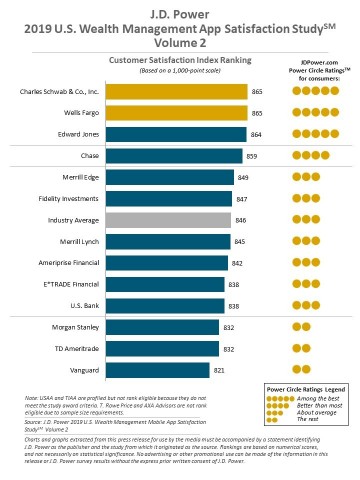COSTA MESA, Calif.--(BUSINESS WIRE)--Investors are not impressed with the mobile apps their brokerage firms are providing. According to the J.D. Power 2019 U.S. Wealth Management Mobile App Satisfaction Study℠ Volume 2, released today, customer satisfaction with wealth mobile apps significantly lags those provided by other consumer financial companies, including credit cards, retail banks and insurance. When wealth management firms do get the app formula right, however, clients are more likely to stay with and purchase additional products and services from those firms.
“The stakes are incredibly high for wealth management firms to deliver an exceptional mobile experience,” said Michael Foy, Senior Director of Wealth & Lending Intelligence at J.D. Power. “With competition intensifying to gain share of wallet across the various financial needs of emerging affluent clients, the mobile experience is a critical factor influencing investor decisions about considering new products and services.”
Following are key findings of the study:
- Wealth management apps are behind: The average overall customer satisfaction score for wealth management mobile apps is 846 (on a 1,000-point scale). That trails overall satisfaction with credit card apps (872) and retail banking apps (853).
- Security, simplicity and personalization are critical but inconsistent: Overall satisfaction improves by 43 points when customers perceive their personal information on an app is very secure, but one-third of customers say their firm misses the mark. Only half of customers say that the app provides personalized advice and insights, indicating that, while the app may offer a lot of features and functionality, the experience is often not being tailored to reflect their unique needs and objectives.
- Millennials1 most likely to be influenced by the app experience: Among Millennials who say the overall mobile app experience is “outstanding,” 77% strongly agreed they are likely to sign up for additional products and services, vs. just 26% of those with lower satisfaction. Unfortunately, just 30% of Millennials rate their app as outstanding.
- Communication is vital but challenging: Nearly half (49%) of wealth management mobile app users indicate that the ability to send and receive secure messages is the most important communication tool provided by the app. However, 36% of customers do not find this feature very easy to use.
“Increasingly, we’re seeing a common set of best practices emerge among consumer financial apps that resonate most with customers,” said Amit Aggarwal, Senior Director of Digital Solutions at J.D. Power. “Ultimately, you need both intuitive design and an appropriate feature set in order to meet customer expectations. Banks and credit card companies have been raising the bar by doing just that. Meanwhile, personalization is emerging as a powerful mechanism to help strike this balance.
The 2019 U.S. Wealth Management Mobile App Satisfaction Study evaluates customer satisfaction with wealth management mobile apps based on five factors (in order of importance): range of services; clarity of information; ease of navigating app; appearance; and speed of screens loading. The study is based on responses from 2,892 full-service and self-directed wealth management firm customers. The study was fielded in July-August 2019.
Wealth Management App Rankings
Charles Schwab & Co., Inc., and Wells Fargo rank highest in a tie in overall customer satisfaction with wealth management apps, each with a score of 865. Edward Jones ranks third with a score of 864.
For more information about the J.D. Power U.S. Wealth Management Mobile App Satisfaction Study, visit https://www.jdpower.com/business/resource/us-wealth-mobile-app-study.
See the online press release at http://www.jdpower.com/pr-id/2019234.
J.D. Power is a global leader in consumer insights, advisory services and data and analytics. These capabilities enable J.D. Power to help its clients drive customer satisfaction, growth and profitability. Established in 1968, J.D. Power has offices serving North America, South America, Asia Pacific and Europe.
About J.D. Power and Advertising/Promotional Rules: www.jdpower.com/business/about-us/press-release-info
______________________________
1 J.D. Power defines generational groups as Pre-Boomers (born before 1946); Boomers (1946-1964); Gen X (1965-1976); Gen Y (1977-1994); and Gen Z (1995-2004). Millennials (1982-1994) are a subset of Gen Y.




